87f768e21ec2a444d95d7c21d71bdd7a.ppt
- Количество слайдов: 67
 The Role of Schools in Alleviating Social and Economic Disadvantage: Students In Low Income Howell Wechsler, Ed. D. , MPH Communities Diane Allensworth, Ph. D Within High Income Countries Carolyn Fisher, Ed. D. "The findings and conclusions in this presentation are those of the authors and do not necessarily represent the views of the CDC/the Agency for Toxic Substances and Disease Registry. “ (CS 111689)
The Role of Schools in Alleviating Social and Economic Disadvantage: Students In Low Income Howell Wechsler, Ed. D. , MPH Communities Diane Allensworth, Ph. D Within High Income Countries Carolyn Fisher, Ed. D. "The findings and conclusions in this presentation are those of the authors and do not necessarily represent the views of the CDC/the Agency for Toxic Substances and Disease Registry. “ (CS 111689)
 Overview § Background: Health and education disparities in the U. S. § 7 school health strategies for alleviating social and economic disadvantage
Overview § Background: Health and education disparities in the U. S. § 7 school health strategies for alleviating social and economic disadvantage
 Two Overarching Goals § Increase quality and years of healthy life § Eliminate health disparities
Two Overarching Goals § Increase quality and years of healthy life § Eliminate health disparities
 Health disparities are the differences in the incidence, prevalence, mortality, and burden of diseases and other adverse health conditions that exist among specific population groups in the United States § Poor / low socio-economic (SES) populations § Minority populations • • African American Hispanic Native American Asian
Health disparities are the differences in the incidence, prevalence, mortality, and burden of diseases and other adverse health conditions that exist among specific population groups in the United States § Poor / low socio-economic (SES) populations § Minority populations • • African American Hispanic Native American Asian
 Percentage of U. S. Children Under 18 Living in Poverty by Racial/Ethnic Group, 2004 Source: U. S. Bureau of the Census. Income, Poverty, and Health Insurance Coverage in the U. S. : 2004. Report P 60, no. 229, Table B-2.
Percentage of U. S. Children Under 18 Living in Poverty by Racial/Ethnic Group, 2004 Source: U. S. Bureau of the Census. Income, Poverty, and Health Insurance Coverage in the U. S. : 2004. Report P 60, no. 229, Table B-2.
 Compared with All U. S. Children, Poor Children § Have poor health and chronic health conditions 1 in U. S. Are More Likely to: § Be born premature and at a low birth weight. 2 -3 § Suffer from mental health conditions, such as personality disorders and depression. 2 -3 § Have behavioral problems such as increased aggression and emotional problems. 4 -5 § Engage in risky health-related behaviors, such as smoking and early initiation of sexual activity. 2 -3 1 - Bradley RH & Corwyn RF. Ann Rev Psych 2002; 53: 371 -99. 2 - Haveman R et al. Childhood Poverty and Adolescent Schooling and Fertility Outcomes. In Duncan GJ and Brooks-Gunn J (eds) Consequences of Growing Up Poor: Russell Sage, 1997. 3 - Brooks-Gunn J and Duncan GJ. The Effects of Poverty on Children. Future of Children, Child and Poverty, 1997; 7(2). 4 - Huffman LC et al. Risk Factors for Academic and Behavioral Problems at the Beginning of School. The Child and Mental Health Foundation Agencies Network, 2000.
Compared with All U. S. Children, Poor Children § Have poor health and chronic health conditions 1 in U. S. Are More Likely to: § Be born premature and at a low birth weight. 2 -3 § Suffer from mental health conditions, such as personality disorders and depression. 2 -3 § Have behavioral problems such as increased aggression and emotional problems. 4 -5 § Engage in risky health-related behaviors, such as smoking and early initiation of sexual activity. 2 -3 1 - Bradley RH & Corwyn RF. Ann Rev Psych 2002; 53: 371 -99. 2 - Haveman R et al. Childhood Poverty and Adolescent Schooling and Fertility Outcomes. In Duncan GJ and Brooks-Gunn J (eds) Consequences of Growing Up Poor: Russell Sage, 1997. 3 - Brooks-Gunn J and Duncan GJ. The Effects of Poverty on Children. Future of Children, Child and Poverty, 1997; 7(2). 4 - Huffman LC et al. Risk Factors for Academic and Behavioral Problems at the Beginning of School. The Child and Mental Health Foundation Agencies Network, 2000.
 Percentage of Children in U. S. Facing Social Hardships by Poverty Status Mother HS dropout -------------Single parent -------------------Teen parent ------------Poor neighborhood ---------3 or more siblings ----------Few children books -------------in house 50 ------ Poor Children 0 10 _____ Non-poor children 20 30 40
Percentage of Children in U. S. Facing Social Hardships by Poverty Status Mother HS dropout -------------Single parent -------------------Teen parent ------------Poor neighborhood ---------3 or more siblings ----------Few children books -------------in house 50 ------ Poor Children 0 10 _____ Non-poor children 20 30 40
 Percent with fair or poor health Fair or Poor Health, by Race/Ethnicity and Income, 2001 White (Non. Latino) Latino African American (Non< 100% of Latino) Poverty Data: National Center for Health Statistics, National Health Interview Survey. Source: Health, United States, 2003, Table 57. White Latino African (Non. American Latino) (Non 200% + of Latino) Poverty
Percent with fair or poor health Fair or Poor Health, by Race/Ethnicity and Income, 2001 White (Non. Latino) Latino African American (Non< 100% of Latino) Poverty Data: National Center for Health Statistics, National Health Interview Survey. Source: Health, United States, 2003, Table 57. White Latino African (Non. American Latino) (Non 200% + of Latino) Poverty
 Compared with White Non-Hispanic Youth in U. S. , Black Non-Hispanic and Hispanic Youth Have: § Higher all-cause death rates § Higher death rates from homicide § Higher rates of teen pregnancy and STDs § Higher prevalence of overweight and type 2 diabetes § Higher prevalence of untreated dental caries
Compared with White Non-Hispanic Youth in U. S. , Black Non-Hispanic and Hispanic Youth Have: § Higher all-cause death rates § Higher death rates from homicide § Higher rates of teen pregnancy and STDs § Higher prevalence of overweight and type 2 diabetes § Higher prevalence of untreated dental caries
 Percentage of Children in U. S. Facing Social Hardships by Racial / Ethnic. Black % Group White% Hispanic % Mother HS dropout 7 Single parent 15 Teen parent 10 19 Low quality neighborhood 5 21 3 or more siblings 11 18 Few children books 2 18 50 15 24 22 23 21 20 29
Percentage of Children in U. S. Facing Social Hardships by Racial / Ethnic. Black % Group White% Hispanic % Mother HS dropout 7 Single parent 15 Teen parent 10 19 Low quality neighborhood 5 21 3 or more siblings 11 18 Few children books 2 18 50 15 24 22 23 21 20 29
 Percentage of High School Students Who Had Sexual Risk Behaviors, by Race / Ethnicity, * 2005 Had First Sexual Intercourse Before Age 13 Years *B>H>W Source: National Youth Risk Behavior Survey, 2005 Had Sexual Intercourse with >4 Persons During Their Life
Percentage of High School Students Who Had Sexual Risk Behaviors, by Race / Ethnicity, * 2005 Had First Sexual Intercourse Before Age 13 Years *B>H>W Source: National Youth Risk Behavior Survey, 2005 Had Sexual Intercourse with >4 Persons During Their Life
 Percentage of High School Students Who Actually Attempted Suicide, * by Sex and Race/Ethnicity, ** 2005 Females * One or more times during the 12 months preceding the survey; ** Females: H > W, B; Males: H > W National Youth Risk Behavior Survey, 2005 Source: CDC, Males
Percentage of High School Students Who Actually Attempted Suicide, * by Sex and Race/Ethnicity, ** 2005 Females * One or more times during the 12 months preceding the survey; ** Females: H > W, B; Males: H > W National Youth Risk Behavior Survey, 2005 Source: CDC, Males
 Disparities in Health Care Access Among U. S. Adolescents by Racial /Ethnic Whites Blacks Hispanics Group No Health Care Visit in >1 Year 9% 14% 23% No Mental Health Care Last Year* 29% 47% 53% No Preventive Dental Care Visit Last Year 29% 30% 47% *Even though reported mild-severe emotional/behavioral problems Source: Fox et al. Racial and Ethnic Disparities in Adolescent Health and access to care. Fact Sheet for the Advancement of Adoles In Center Strategies. No. 1, January 2007.
Disparities in Health Care Access Among U. S. Adolescents by Racial /Ethnic Whites Blacks Hispanics Group No Health Care Visit in >1 Year 9% 14% 23% No Mental Health Care Last Year* 29% 47% 53% No Preventive Dental Care Visit Last Year 29% 30% 47% *Even though reported mild-severe emotional/behavioral problems Source: Fox et al. Racial and Ethnic Disparities in Adolescent Health and access to care. Fact Sheet for the Advancement of Adoles In Center Strategies. No. 1, January 2007.
 Causes of Health Disparities § Societal Factors: • Poverty • Educational inequalities § Environmental Factors: • Poor physical and social environment • Community norms unsupportive of protective behaviors § Individual/Behavioral Factors: • Individual lifestyle • Language barriers § Medical Care Factors: • Lack of access to preventative care and quality care
Causes of Health Disparities § Societal Factors: • Poverty • Educational inequalities § Environmental Factors: • Poor physical and social environment • Community norms unsupportive of protective behaviors § Individual/Behavioral Factors: • Individual lifestyle • Language barriers § Medical Care Factors: • Lack of access to preventative care and quality care
 Percentage of U. S. Population Age 25 and Above Who Reported Being in Excellent or Very Good Health, by Educational Attainment and Family Income, 2001 Family Income Note: Includes those who responded “excellent” or “very good” on a scale of “excellent, ” “very good, ” “fair, ” and “poor. ” Source: US, DHHS, CDC, Control, National Center for Health Statistics, National Health Interview Survey, 2001, previously unpublished tabulation (Oct. 2003).
Percentage of U. S. Population Age 25 and Above Who Reported Being in Excellent or Very Good Health, by Educational Attainment and Family Income, 2001 Family Income Note: Includes those who responded “excellent” or “very good” on a scale of “excellent, ” “very good, ” “fair, ” and “poor. ” Source: US, DHHS, CDC, Control, National Center for Health Statistics, National Health Interview Survey, 2001, previously unpublished tabulation (Oct. 2003).
 Healthy People 2010 Objective 7 -1: Increase High School Completion § Dropping out of school before high school graduation is associated with: • substance abuse • delinquency • intentional and unintentional injury • unintended pregnancy • poor long-term health
Healthy People 2010 Objective 7 -1: Increase High School Completion § Dropping out of school before high school graduation is associated with: • substance abuse • delinquency • intentional and unintentional injury • unintended pregnancy • poor long-term health
 Performance on National Reading Test, 4 th Grade, by Family Income, 2003 Source: USDOE, NCES, National Assessment of Educational Progress (NAEP)
Performance on National Reading Test, 4 th Grade, by Family Income, 2003 Source: USDOE, NCES, National Assessment of Educational Progress (NAEP)
 Performance on National Reading Test, 4 th Grade, by Race, Ethnicity, 2003 Source: USDOE, NCES, National Assessment of Educational Progress (NAEP)
Performance on National Reading Test, 4 th Grade, by Race, Ethnicity, 2003 Source: USDOE, NCES, National Assessment of Educational Progress (NAEP)
 Educational Attainment Among Native Born U. S. Young Adults, Ages 24 -26 Source: Original analysis by Child Trends of 2001 Current Population Survey Data. Wald M and Martinez T. Connected by 25: Improving the Life Chances of the Country’s Most Vulnerable 14 -24 Year Olds. Stanford University; William and Flora Hewlett Foundation Working Paper. November, 2003.
Educational Attainment Among Native Born U. S. Young Adults, Ages 24 -26 Source: Original analysis by Child Trends of 2001 Current Population Survey Data. Wald M and Martinez T. Connected by 25: Improving the Life Chances of the Country’s Most Vulnerable 14 -24 Year Olds. Stanford University; William and Flora Hewlett Foundation Working Paper. November, 2003.
 Causes of the Education Achievement Gap § Poverty § Poor health § Lack of early-childhood instruction § Attending high poverty schools • Inequitable education resources • Lack of credentialed/experienced teachers • Curricular deficiencies
Causes of the Education Achievement Gap § Poverty § Poor health § Lack of early-childhood instruction § Attending high poverty schools • Inequitable education resources • Lack of credentialed/experienced teachers • Curricular deficiencies
 Positive Effects of Participation in Early Childhood Development Programs Such as Head Start § Less likely to be retained in grade and placed in special education § Higher scores on standardized achievement tests § Improved high school graduation rates § Decreased teen pregnancy § Decreased delinquency § Higher rates of employment and home ownership Source: The effectiveness of early child development programs: A systematic review. Am J Prev Med, Vol. 24, No. 3 S
Positive Effects of Participation in Early Childhood Development Programs Such as Head Start § Less likely to be retained in grade and placed in special education § Higher scores on standardized achievement tests § Improved high school graduation rates § Decreased teen pregnancy § Decreased delinquency § Higher rates of employment and home ownership Source: The effectiveness of early child development programs: A systematic review. Am J Prev Med, Vol. 24, No. 3 S
 Participation in Early Childhood Education in the U. S. § In 2005, 47% of 3 - to 5 -year-olds living below the poverty threshold participated in center-based, early childhood care and education programs, compared with 60% of 3 - to 5 -year olds living above the poverty threshold. § In 2001, only 28% of children living in neighborhoods with high concentrations of child poverty participated in a Head Start Program. Source: www. childtrendsdatabank. org/indicators
Participation in Early Childhood Education in the U. S. § In 2005, 47% of 3 - to 5 -year-olds living below the poverty threshold participated in center-based, early childhood care and education programs, compared with 60% of 3 - to 5 -year olds living above the poverty threshold. § In 2001, only 28% of children living in neighborhoods with high concentrations of child poverty participated in a Head Start Program. Source: www. childtrendsdatabank. org/indicators
 Funding Gaps Between High- and Low-Poverty Districts Per Student in U. S. and Sample U. S. States, 2001 -2002 U. S. $ 868 Illinois: $2, 026 New York: $2, 040 Pennsylvania: $ 882 Virginia: $1, 105 Source: The Funding Gap 2004, available at www. edtrust. org
Funding Gaps Between High- and Low-Poverty Districts Per Student in U. S. and Sample U. S. States, 2001 -2002 U. S. $ 868 Illinois: $2, 026 New York: $2, 040 Pennsylvania: $ 882 Virginia: $1, 105 Source: The Funding Gap 2004, available at www. edtrust. org
 Percentage of Inexperienced* Teachers in Schools with High and Low Enrollment of Poor and Minority Students in U. S. *Teachers with 3 or fewer years of experience. “High” and “low” refer to top and bottom quartiles. Source: National Center for Education Statistics, “Monitoring Quality: An Indicators Report, ” December 2000.
Percentage of Inexperienced* Teachers in Schools with High and Low Enrollment of Poor and Minority Students in U. S. *Teachers with 3 or fewer years of experience. “High” and “low” refer to top and bottom quartiles. Source: National Center for Education Statistics, “Monitoring Quality: An Indicators Report, ” December 2000.
 Percentage of Out-of-Field* Teachers in Schools with High and Low Enrollment of Poor and Minority Students in U. S. *Teachers lacking a college major or minor in the field. Data for secondary-level core academic classes. Source: Richard M. Ingersoll, University of Pennsylvania. Original analysis for the Ed Trust of 1999 -2000 Schools and Staffing Surve
Percentage of Out-of-Field* Teachers in Schools with High and Low Enrollment of Poor and Minority Students in U. S. *Teachers lacking a college major or minor in the field. Data for secondary-level core academic classes. Source: Richard M. Ingersoll, University of Pennsylvania. Original analysis for the Ed Trust of 1999 -2000 Schools and Staffing Surve
 STRATEGY 1: Support Efforts to Reduce the Educational Achievement Gap
STRATEGY 1: Support Efforts to Reduce the Educational Achievement Gap
 North Carolina – 4 th Grade Math Black-White Gap Narrows by 18 Points Source: North Carolina Department of Public Instruction, http: //www. dpi. state. nc. us/
North Carolina – 4 th Grade Math Black-White Gap Narrows by 18 Points Source: North Carolina Department of Public Instruction, http: //www. dpi. state. nc. us/
 National 4 th Grade Reading Test Scores Among All Students in U. S. , and Lowincome Black Students in U. S. and Delaware Source: USDOE, NCES, National Assessment of Educational Progress (NAEP)
National 4 th Grade Reading Test Scores Among All Students in U. S. , and Lowincome Black Students in U. S. and Delaware Source: USDOE, NCES, National Assessment of Educational Progress (NAEP)
 What Can Make the Difference? § High-quality early childhood education § Rigorous, challenging curricula for all § Equitable distribution of funding and teacher talent
What Can Make the Difference? § High-quality early childhood education § Rigorous, challenging curricula for all § Equitable distribution of funding and teacher talent
 STRATEGY 2: Implement Effective School Health Programs
STRATEGY 2: Implement Effective School Health Programs
 Percentage of U. S. High School Students Getting Mostly A’s or Mostly B’s and Mostly D’s or F’s* Who Engage in Selected Health Risk Behaviors *As reported by students Source: Unpublished analyses of CDC, National Youth Risk Behavior Survey, 2003
Percentage of U. S. High School Students Getting Mostly A’s or Mostly B’s and Mostly D’s or F’s* Who Engage in Selected Health Risk Behaviors *As reported by students Source: Unpublished analyses of CDC, National Youth Risk Behavior Survey, 2003
 The 8 Components of a Coordinated School Health Program Health Education Family and Community Involvement Physical Education Health Services Health Promotion for Staff Nutrition Services Healthy and Safe School Environment Counseling, Psychological, and Social Services
The 8 Components of a Coordinated School Health Program Health Education Family and Community Involvement Physical Education Health Services Health Promotion for Staff Nutrition Services Healthy and Safe School Environment Counseling, Psychological, and Social Services
 School Health Interventions and Academic Achievement § Physical Education (Project Spark, Sallis et al. 1999) • Higher reading scores on the Metropolitan Achievement Test • Program did not interfere with academic achievement § Nutrition Services (School Breakfast Program, Meyers et al. 1989, Murphy et al. 1998) • Improved academic achievement outcomes • Increased math grades • Decreased absences and tardy rates
School Health Interventions and Academic Achievement § Physical Education (Project Spark, Sallis et al. 1999) • Higher reading scores on the Metropolitan Achievement Test • Program did not interfere with academic achievement § Nutrition Services (School Breakfast Program, Meyers et al. 1989, Murphy et al. 1998) • Improved academic achievement outcomes • Increased math grades • Decreased absences and tardy rates
 School Health Interventions and Academic Achievement Addressing multiple CSHP components § Family Community Involvement, Health Education, and Healthy School Environment (Seattle Social Development Project, O’Donnell et al. 1995, Hawkins et al. 1999) • Improved achievement test scores and grades for boys, not for girls • Follow-up study showed better school achievement by grade 12 and greater commitment and attachment to school § Health Education and Family and Community Involvement (Asthma Self-management Program, Evans et al. 1987) • Improved academic grades
School Health Interventions and Academic Achievement Addressing multiple CSHP components § Family Community Involvement, Health Education, and Healthy School Environment (Seattle Social Development Project, O’Donnell et al. 1995, Hawkins et al. 1999) • Improved achievement test scores and grades for boys, not for girls • Follow-up study showed better school achievement by grade 12 and greater commitment and attachment to school § Health Education and Family and Community Involvement (Asthma Self-management Program, Evans et al. 1987) • Improved academic grades
 Making the Connection: Health and Student Achievement www. thesociety. org Society of State Directors of Health, Physical Education and Recreation (SSDHPER) Association of State and Territorial Health Officials (ASTHO) 35 © 2002 Association of State and Territorial Health Officials (ASTHO) and the Society of State Directors of Health, Physical Education and Recreation (SSDHPER)
Making the Connection: Health and Student Achievement www. thesociety. org Society of State Directors of Health, Physical Education and Recreation (SSDHPER) Association of State and Territorial Health Officials (ASTHO) 35 © 2002 Association of State and Territorial Health Officials (ASTHO) and the Society of State Directors of Health, Physical Education and Recreation (SSDHPER)
 STRATEGY 3: Promote Collaboration Across the Health and Education Sectors
STRATEGY 3: Promote Collaboration Across the Health and Education Sectors
 CDC Funds State Education Agencies to Partner with State Health Departments in Helping Schools Implement CSHP and Prevent Chronic Disease Risks
CDC Funds State Education Agencies to Partner with State Health Departments in Helping Schools Implement CSHP and Prevent Chronic Disease Risks
 Professional Development for State Agencies by State Agency Health and Education Professionals with a Focus on To advance the understanding and Collaboration implementation of CSHPs within schools § National Association of Chronic Disease Directors § Directors of Health Promotion and Education § Society of State Directors of Health, Physical Education, and Recreation
Professional Development for State Agencies by State Agency Health and Education Professionals with a Focus on To advance the understanding and Collaboration implementation of CSHPs within schools § National Association of Chronic Disease Directors § Directors of Health Promotion and Education § Society of State Directors of Health, Physical Education, and Recreation
 How Schools Work and How to Work with Schools § How education works at the school, district, state, and national levels § Practical tips for how to work with educators, administrators, and policymakers www. nasbe. org Coming Soon How Health Departments Work and How to Work with Health Departments by the National Association of Chronic Disease Directors
How Schools Work and How to Work with Schools § How education works at the school, district, state, and national levels § Practical tips for how to work with educators, administrators, and policymakers www. nasbe. org Coming Soon How Health Departments Work and How to Work with Health Departments by the National Association of Chronic Disease Directors
 STRATEGY 4: Promote a Coordinated Approach to School Health
STRATEGY 4: Promote a Coordinated Approach to School Health
 Source: Talking About Health is Academic, 1999
Source: Talking About Health is Academic, 1999
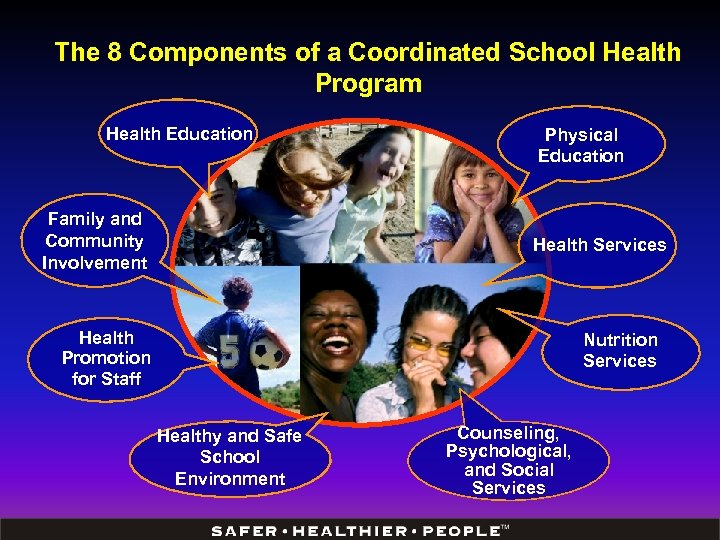 The 8 Components of a Coordinated School Health Program Health Education Family and Community Involvement Physical Education Health Services Health Promotion for Staff Nutrition Services Healthy and Safe School Environment Counseling, Psychological, and Social Services
The 8 Components of a Coordinated School Health Program Health Education Family and Community Involvement Physical Education Health Services Health Promotion for Staff Nutrition Services Healthy and Safe School Environment Counseling, Psychological, and Social Services
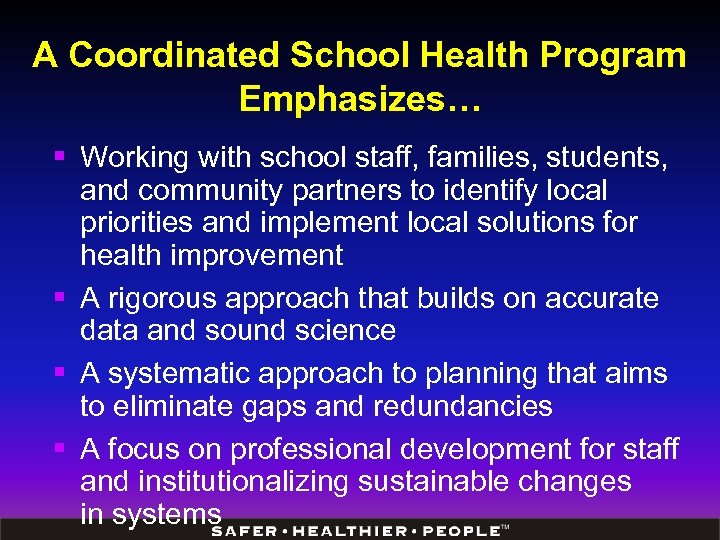 A Coordinated School Health Program Emphasizes… § Working with school staff, families, students, and community partners to identify local priorities and implement local solutions for health improvement § A rigorous approach that builds on accurate data and sound science § A systematic approach to planning that aims to eliminate gaps and redundancies § A focus on professional development for staff and institutionalizing sustainable changes in systems
A Coordinated School Health Program Emphasizes… § Working with school staff, families, students, and community partners to identify local priorities and implement local solutions for health improvement § A rigorous approach that builds on accurate data and sound science § A systematic approach to planning that aims to eliminate gaps and redundancies § A focus on professional development for staff and institutionalizing sustainable changes in systems

 Racial and Ethnic Approaches to Community Health (REACH) Health Priority Areas and Populations Priority Areas: Populations: § Infant Mortality § African American § Breast and Cervical Cancer Screening and Management § Alaska Native § Cardiovascular Diseases § Diabetes § HIV/AIDS § Immunizations § American Indian § Asian American § Hispanic American § Pacific Islander
Racial and Ethnic Approaches to Community Health (REACH) Health Priority Areas and Populations Priority Areas: Populations: § Infant Mortality § African American § Breast and Cervical Cancer Screening and Management § Alaska Native § Cardiovascular Diseases § Diabetes § HIV/AIDS § Immunizations § American Indian § Asian American § Hispanic American § Pacific Islander
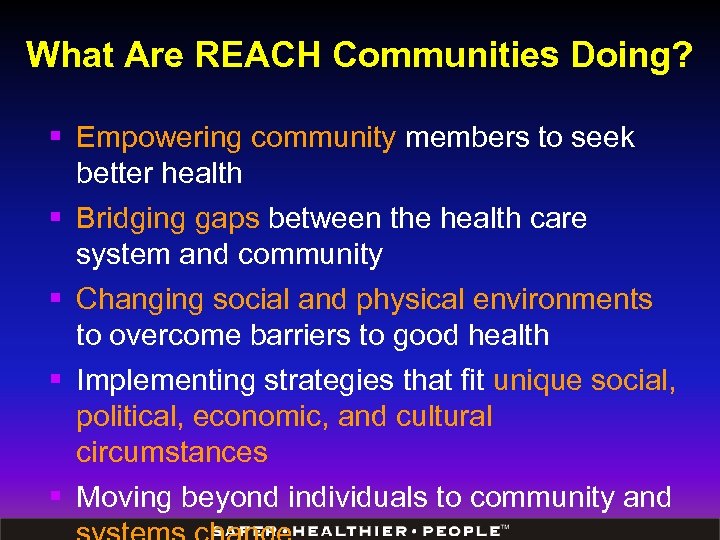 What Are REACH Communities Doing? § Empowering community members to seek better health § Bridging gaps between the health care system and community § Changing social and physical environments to overcome barriers to good health § Implementing strategies that fit unique social, political, economic, and cultural circumstances § Moving beyond individuals to community and
What Are REACH Communities Doing? § Empowering community members to seek better health § Bridging gaps between the health care system and community § Changing social and physical environments to overcome barriers to good health § Implementing strategies that fit unique social, political, economic, and cultural circumstances § Moving beyond individuals to community and
 Health Outcomes in REACH Communities: American Indians with High Blood Pressure Currently on Medication * Data from REACH 2010 communities that focus on Cardiovascular Disease/Diabetes. BRFSS = Behavioral Risk Factor Surveillance System
Health Outcomes in REACH Communities: American Indians with High Blood Pressure Currently on Medication * Data from REACH 2010 communities that focus on Cardiovascular Disease/Diabetes. BRFSS = Behavioral Risk Factor Surveillance System
 Health Outcomes in REACH Communities: Smoking Prevalence Among Asian Men, 2002 -2006* * Data from REACH 2010 communities that focus on Cardiovascular Disease/Diabetes
Health Outcomes in REACH Communities: Smoking Prevalence Among Asian Men, 2002 -2006* * Data from REACH 2010 communities that focus on Cardiovascular Disease/Diabetes
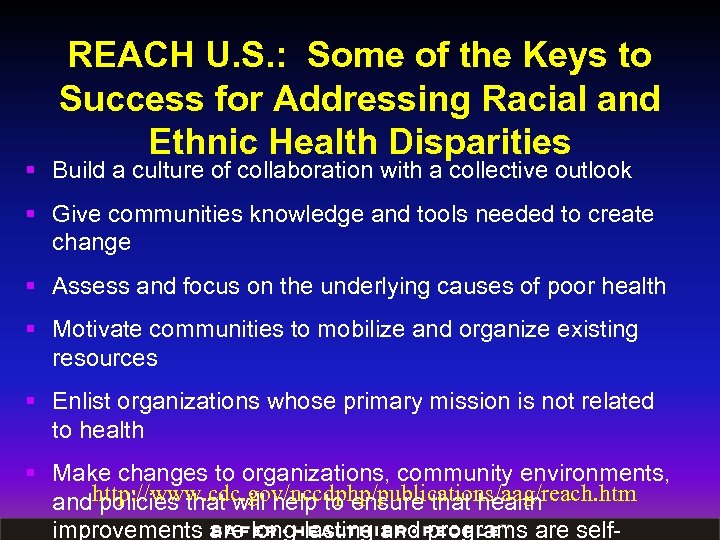 REACH U. S. : Some of the Keys to Success for Addressing Racial and Ethnic Health Disparities § Build a culture of collaboration with a collective outlook § Give communities knowledge and tools needed to create change § Assess and focus on the underlying causes of poor health § Motivate communities to mobilize and organize existing resources § Enlist organizations whose primary mission is not related to health § Make changes to organizations, community environments, andhttp: //www. cdc. gov/nccdphp/publications/aag/reach. htm policies that will help to ensure that health improvements are long-lasting and programs are self-
REACH U. S. : Some of the Keys to Success for Addressing Racial and Ethnic Health Disparities § Build a culture of collaboration with a collective outlook § Give communities knowledge and tools needed to create change § Assess and focus on the underlying causes of poor health § Motivate communities to mobilize and organize existing resources § Enlist organizations whose primary mission is not related to health § Make changes to organizations, community environments, andhttp: //www. cdc. gov/nccdphp/publications/aag/reach. htm policies that will help to ensure that health improvements are long-lasting and programs are self-
 STRATEGY 5: Address Root Causes …Such as School Connectedness
STRATEGY 5: Address Root Causes …Such as School Connectedness
 Definition of School Connectedness (n. ) The belief by students that adults and peers in the school care about their learning as well as about them as individuals.
Definition of School Connectedness (n. ) The belief by students that adults and peers in the school care about their learning as well as about them as individuals.
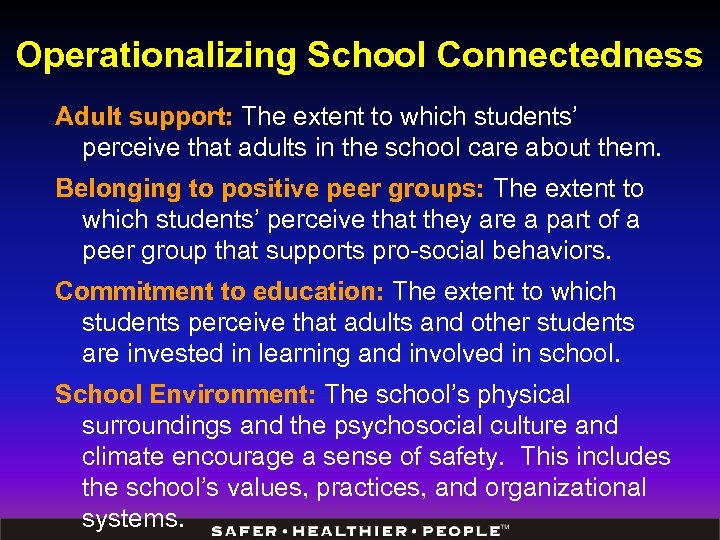 Operationalizing School Connectedness Adult support: The extent to which students’ perceive that adults in the school care about them. Belonging to positive peer groups: The extent to which students’ perceive that they are a part of a peer group that supports pro-social behaviors. Commitment to education: The extent to which students perceive that adults and other students are invested in learning and involved in school. School Environment: The school’s physical surroundings and the psychosocial culture and climate encourage a sense of safety. This includes the school’s values, practices, and organizational systems.
Operationalizing School Connectedness Adult support: The extent to which students’ perceive that adults in the school care about them. Belonging to positive peer groups: The extent to which students’ perceive that they are a part of a peer group that supports pro-social behaviors. Commitment to education: The extent to which students perceive that adults and other students are invested in learning and involved in school. School Environment: The school’s physical surroundings and the psychosocial culture and climate encourage a sense of safety. This includes the school’s values, practices, and organizational systems.
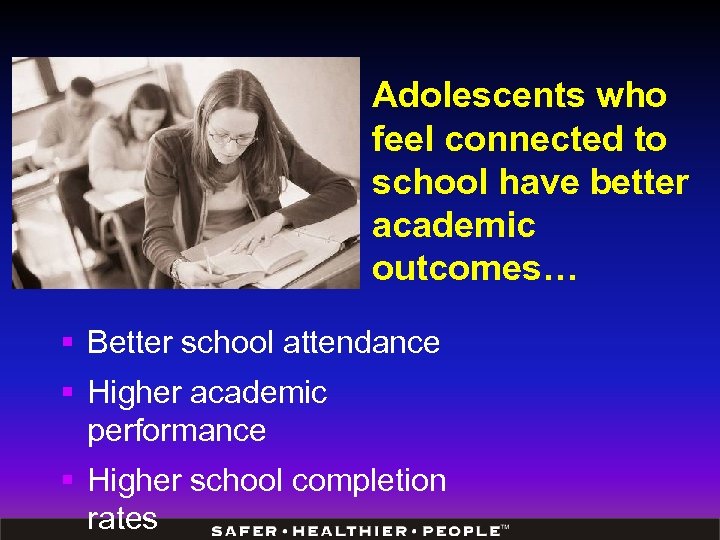 Adolescents who feel connected to school have better academic outcomes… § Better school attendance § Higher academic performance § Higher school completion rates
Adolescents who feel connected to school have better academic outcomes… § Better school attendance § Higher academic performance § Higher school completion rates
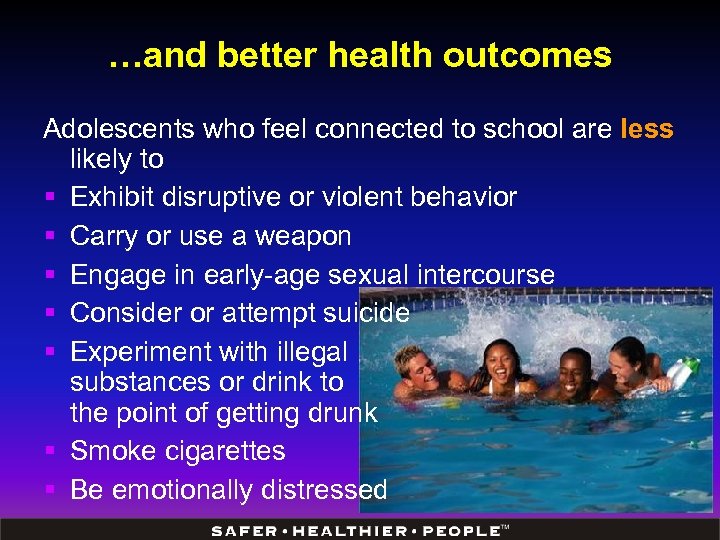 …and better health outcomes Adolescents who feel connected to school are less likely to § Exhibit disruptive or violent behavior § Carry or use a weapon § Engage in early-age sexual intercourse § Consider or attempt suicide § Experiment with illegal substances or drink to the point of getting drunk § Smoke cigarettes § Be emotionally distressed
…and better health outcomes Adolescents who feel connected to school are less likely to § Exhibit disruptive or violent behavior § Carry or use a weapon § Engage in early-age sexual intercourse § Consider or attempt suicide § Experiment with illegal substances or drink to the point of getting drunk § Smoke cigarettes § Be emotionally distressed
 Strategies for Increasing School Connectedness § Create administrative and organizational structures that facilitate academic achievement, family and community engagement, and staff empowerment. § Promote an atmosphere that encourages open communication, positive norms, and respect for individual differences. § Provide education and opportunities to enable families to be actively involved in their child’s academic and school life.
Strategies for Increasing School Connectedness § Create administrative and organizational structures that facilitate academic achievement, family and community engagement, and staff empowerment. § Promote an atmosphere that encourages open communication, positive norms, and respect for individual differences. § Provide education and opportunities to enable families to be actively involved in their child’s academic and school life.
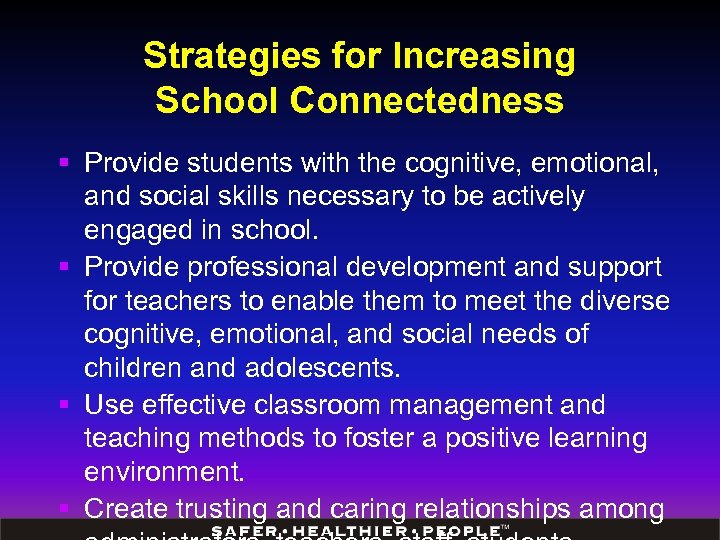 Strategies for Increasing School Connectedness § Provide students with the cognitive, emotional, and social skills necessary to be actively engaged in school. § Provide professional development and support for teachers to enable them to meet the diverse cognitive, emotional, and social needs of children and adolescents. § Use effective classroom management and teaching methods to foster a positive learning environment. § Create trusting and caring relationships among
Strategies for Increasing School Connectedness § Provide students with the cognitive, emotional, and social skills necessary to be actively engaged in school. § Provide professional development and support for teachers to enable them to meet the diverse cognitive, emotional, and social needs of children and adolescents. § Use effective classroom management and teaching methods to foster a positive learning environment. § Create trusting and caring relationships among
 STRATEGY 6: Implement Effective Out-of-School Time Programs
STRATEGY 6: Implement Effective Out-of-School Time Programs
 Out-of-School Time Programs and Activities Can Foster… § § § § Increased academic achievement Increased school attendance Increased enjoyment and effort in school Better student behavior and work habits Stronger relationships with adults Increased feelings of personal efficacy Higher educational aspirations Source: Scott-Little C et al. Evaluations of after-school programs: A meta-evaluation of methodologies and narrative synthesis of findings. Am J Evaluation 2002: 23(4): 387 -419.
Out-of-School Time Programs and Activities Can Foster… § § § § Increased academic achievement Increased school attendance Increased enjoyment and effort in school Better student behavior and work habits Stronger relationships with adults Increased feelings of personal efficacy Higher educational aspirations Source: Scott-Little C et al. Evaluations of after-school programs: A meta-evaluation of methodologies and narrative synthesis of findings. Am J Evaluation 2002: 23(4): 387 -419.
 § Examples of Health-Related OST Programs Be Proud! Be Responsible!1 • Reduced incidence of risky behaviors leading to pregnancy § CATCH Kids Club 2 • Increased time spent in moderate to vigorous physical activity during play time § Big Brothers/Big Sisters of America 3 • Decreased likelihood of initiating alcohol or drug use or being violent • Improved academic behaviors, attitudes, and performance 1. Jemmott JB, Jemmott LS, Fong GT. Reductions in HIV risk-associated sexual behaviors among black male adolescents: effects of an AIDS prevention intervention. American Journal of Public Health 1992; 82: 372 -377. 2. Kelder S, Hoelscher DM, Barroso CS, Walker JL, Cribb P, Hu S. The CATCH kids club: a pilot after-school study for improving elementary students’ nutrition and physical activity. Public Health Nutrition 2005; 8(2): 133 -140. 3. Elliot DS, editor. Blueprints for violence prevention: Big Brothers/Big Sisters of America. Boulder, CO: Center for the Study and Prevention of Violence, Institute of Behavioral Science, University of Colorado, 1997.
§ Examples of Health-Related OST Programs Be Proud! Be Responsible!1 • Reduced incidence of risky behaviors leading to pregnancy § CATCH Kids Club 2 • Increased time spent in moderate to vigorous physical activity during play time § Big Brothers/Big Sisters of America 3 • Decreased likelihood of initiating alcohol or drug use or being violent • Improved academic behaviors, attitudes, and performance 1. Jemmott JB, Jemmott LS, Fong GT. Reductions in HIV risk-associated sexual behaviors among black male adolescents: effects of an AIDS prevention intervention. American Journal of Public Health 1992; 82: 372 -377. 2. Kelder S, Hoelscher DM, Barroso CS, Walker JL, Cribb P, Hu S. The CATCH kids club: a pilot after-school study for improving elementary students’ nutrition and physical activity. Public Health Nutrition 2005; 8(2): 133 -140. 3. Elliot DS, editor. Blueprints for violence prevention: Big Brothers/Big Sisters of America. Boulder, CO: Center for the Study and Prevention of Violence, Institute of Behavioral Science, University of Colorado, 1997.
 STRATEGY 7: Promote Family and Community Involvement
STRATEGY 7: Promote Family and Community Involvement
 Family and Community Involvement in Schools Can Foster: § § § Improved student behavior Increased academic achievement Better school attendance Improved school programs and quality Improved school discipline Better social skills Henderson AL, Mapp KT. A New Wave of Evidence: The Impact of School, Family, and Community Connections on Student Achievement. 2002
Family and Community Involvement in Schools Can Foster: § § § Improved student behavior Increased academic achievement Better school attendance Improved school programs and quality Improved school discipline Better social skills Henderson AL, Mapp KT. A New Wave of Evidence: The Impact of School, Family, and Community Connections on Student Achievement. 2002
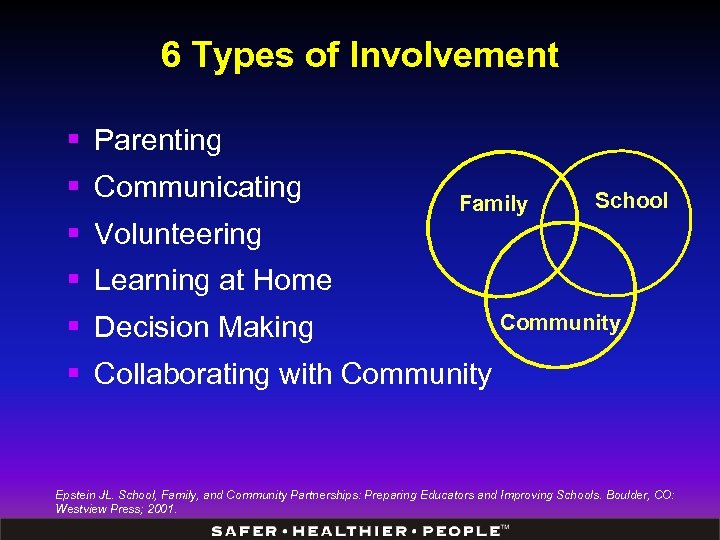 6 Types of Involvement § Parenting § Communicating Family School § Volunteering § Learning at Home § Decision Making Community § Collaborating with Community Epstein JL. School, Family, and Community Partnerships: Preparing Educators and Improving Schools. Boulder, CO: Westview Press; 2001.
6 Types of Involvement § Parenting § Communicating Family School § Volunteering § Learning at Home § Decision Making Community § Collaborating with Community Epstein JL. School, Family, and Community Partnerships: Preparing Educators and Improving Schools. Boulder, CO: Westview Press; 2001.
 Strategies for Family and Community Involvement 1. Have a Vision and Communicate it § Build strong connections between schools and community organizations § Provide families and community members with information about how to be involved in a range of ways § Make sure all understand that the responsibility for children’s education is a Adapted from Henderson AL, Mapp KT. A New Wave of Evidence: The Impact of School, Family, and Community Connections on Student Achievement. 2002 collaborative enterprise
Strategies for Family and Community Involvement 1. Have a Vision and Communicate it § Build strong connections between schools and community organizations § Provide families and community members with information about how to be involved in a range of ways § Make sure all understand that the responsibility for children’s education is a Adapted from Henderson AL, Mapp KT. A New Wave of Evidence: The Impact of School, Family, and Community Connections on Student Achievement. 2002 collaborative enterprise
 Strategies for Family and Community Involvement 2. Create Capacity § Develop the capacity of school staff to work with families and community members § Give teachers time to plan and organize family and community activities § Create programs that will support families to guide their children’s learning, from preschool through high school Adapted from Henderson AL, Mapp KT. A New Wave of Evidence: The Impact of School, Family, and Community Connections on Student Achievement. 2002
Strategies for Family and Community Involvement 2. Create Capacity § Develop the capacity of school staff to work with families and community members § Give teachers time to plan and organize family and community activities § Create programs that will support families to guide their children’s learning, from preschool through high school Adapted from Henderson AL, Mapp KT. A New Wave of Evidence: The Impact of School, Family, and Community Connections on Student Achievement. 2002
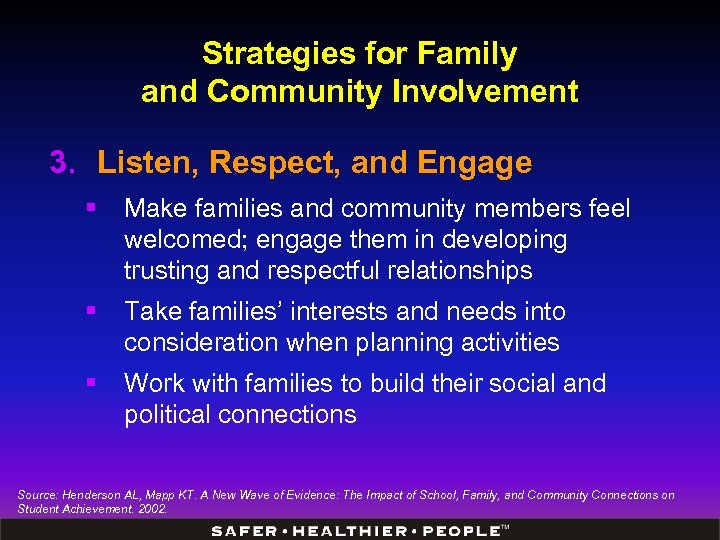 Strategies for Family and Community Involvement 3. Listen, Respect, and Engage § Make families and community members feel welcomed; engage them in developing trusting and respectful relationships § Take families’ interests and needs into consideration when planning activities § Work with families to build their social and political connections Source: Henderson AL, Mapp KT. A New Wave of Evidence: The Impact of School, Family, and Community Connections on Student Achievement. 2002.
Strategies for Family and Community Involvement 3. Listen, Respect, and Engage § Make families and community members feel welcomed; engage them in developing trusting and respectful relationships § Take families’ interests and needs into consideration when planning activities § Work with families to build their social and political connections Source: Henderson AL, Mapp KT. A New Wave of Evidence: The Impact of School, Family, and Community Connections on Student Achievement. 2002.
 Summary § Seven school health strategies for alleviating social and economic disadvantage: 1. Support efforts to reduce the educational achievement gap 2. Implement effective school health programs 3. Promote collaboration across the health and education sectors 4. Promote a coordinated approach to school health 5. Address root causes such as school connectedness
Summary § Seven school health strategies for alleviating social and economic disadvantage: 1. Support efforts to reduce the educational achievement gap 2. Implement effective school health programs 3. Promote collaboration across the health and education sectors 4. Promote a coordinated approach to school health 5. Address root causes such as school connectedness
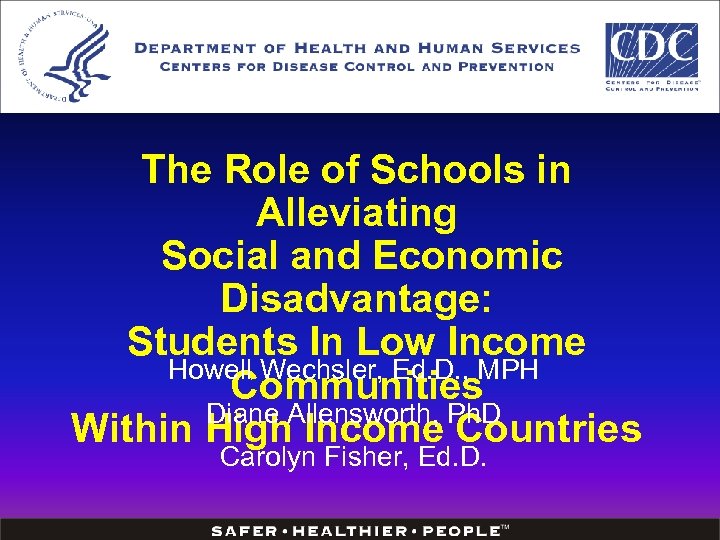 The Role of Schools in Alleviating Social and Economic Disadvantage: Students In Low Income Howell Wechsler, Ed. D. , MPH Communities Diane Allensworth, Ph. D Within High Income Countries Carolyn Fisher, Ed. D.
The Role of Schools in Alleviating Social and Economic Disadvantage: Students In Low Income Howell Wechsler, Ed. D. , MPH Communities Diane Allensworth, Ph. D Within High Income Countries Carolyn Fisher, Ed. D.
